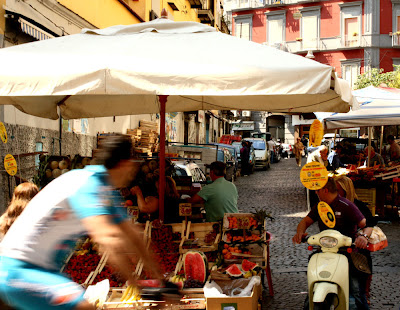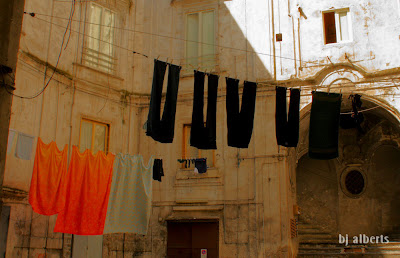May of the Monuments has given us the opportunity to explore parts of Napoli we've never ventured into before. Places rarely listed in the tour guides and that would definitely never make the top ten list. And this Saturday Stroll took us to just one of those places. Our journey was to a cemetery that opens its gates for only two days a year, however along the way we found the religious and historic core of this city. To understand Napoli, you must understand the Quartiere Sanità and the Borgo dei Vergini (Quarter of the Virgins). As fascinating as it is macabre, it lives between wealth and poverty, light and darkness, ecstasy and agony.
Located on the north side of the city, the Quartiere Sanità sits in a valley just beyond the orignal city walls, nestled between the Capodimonte, Materdei, Scudillo, Miradois, and Stella hills. Here, was the final resting place of many Neapolitan souls, buried within the rocky cavities that at the same time gave the materials from which the Neapolitans built their homes. Once accessible only from the city gate - Porta Gennaro, today however, we simply took the Metropolitana Line 2 to the Cavour station.
Popping out of the station we took a left on Via dei Vergini and found ourselves on one of the busiest, liveliest streets we've seen in this city. The daily market was in full swing with shopkeepers calling out their wares, cars and motos weaving in and around the pedestrians shopping in the street (no wider than an alley really), baskets on ropes being dropped from 4th floor walkups so that shoppers didn't have to make the long trek up and down again, and the aroma of flowers, fish and caffe in the air.
As we normally do, a kind of custom I guess, we popped into a cafe and enjoyed a couple of graffe (sugar doughnuts), marmelade filled cornetti and some fresh squeezed orange juice (spremuta). After finishing we made our way back onto the street and wandered the market. Everything you'd ever need could be found here, meat, fish, vegetables, fruit, clothing, cleaning materials... even pots and pans are here. Hundreds of people wandering, buying, catching up with friends, continuing conversations from yesterday or just simply watching it all occur. You know, like a neighborhood.
Right in the middle of the market, we saw a magnificent courtyard on our left, the reknowned Palazzo Spagnuolo. Its magnificent staircase, exemplifying Baroque and Roccoco architecture, was commisioned by Nicola Moscati and designed and built by Baroque architect Ferdinando Sanfelice. The double staircase, known as Ali di Falco (Wings of the Hawk) was meant to provide a social setting so that people could meet and converse. I have to admit, we spent some time here simply admiring this structure (and kinda thinking about moving to this neighborhood).
Wandering through the market we came to a fork in the road. We chose left. The market began to thin as we walked upward and found that we were on Via Arena della Sanita. The narrow street was shared by cars, motos and pedestrians. We were ducking and weaving our way upward when a courtyard struck both our attention. Simple in construction, deteriorated with age and yet beautiful in its simplicity. This wasn't a landmark or a tourist attraction of note, however the laundry hanging across to dry signified that families lived here, making it all that more beautiful to look at.
Smiling as we left the palazzo, we continued upward. Upward is a key word here as this stroll is always uphill. Eventually, we rounded a corner and saw the cupola of Santa Maria della Sanita.
We entered the church, which is also home to the Catacombs of San Gaudioso, and were struck by the magnificent altar. The church interior was white like a cloud and the paintings, mammoth in size befitting the height of the ceilings and the width of this gorgeous structure. We wandered around awestruck. Everywhere we looked there was beauty and peace.
Determined to make it to our original destination, the Cimitero delle Fontanelle (Fontanelle Cemetery), we reluctantly departed. After asking someone in the church courtyard how much further up the hill the cemetery was, we opted to take the C51 bus up the rest of the way. Not your normal bus, more like a huge van, we, along with 20 or so other passengers that were already on it, took the crammed bus up to Piazza Fontanelle.
From Piazza Fontanelle it was another long hike uphill to the cemetery. Once there we were met by a long line of people anxiously awaiting the rare opening of this amazing place. Once we finally got in, we knew why. Never before had we seen anything like this. There are no burial plots, mausoleums or headstones. There are no well manicured lawns or flowers. One enters into a gigantic tuffa rock cave, on a dirt path, and the first sight you see are human skulls and bones neatly stacked (the skulls resting on top of an orderly stack of leg and arm bones). Not one or two, not hundreds, but thousands.
More precisely an ossuary, Cimitero delle Fontanelle is the final resting place for Neopolitans and also served as a paupers cemetery between 1600 and 1800. It has a long and fascinating history, and you can read more about it in our article Naples Fontanelle Cemetery on our website. Let me just say however, that it was definitely a place not to be missed. It is so important in fact, that the Il Mattino reported on Sunday that a group of citizens, social activists, and religious organizations had remained in the ossuary after the last tour on Sunday to protest that the cemetery is only open two days a year.
Leaving here, after catching our breath and gathering our senses, we started the walk down. What else could this "simple" neighborhood have in store for us? About halfway back to the Chiesa Santa Maria della Sanita, we discovered one of Naples' many stairways at the corner of Via Allessandro Telesino.
Wondering how may steps this staircase has? Well without us asking, a 12 or 13 year old raggazo told us, in perfect English I might add, that there are 137 steps. We did not climb them to verify that.
Making our way back to the church, we saw an ascensore (elevator) just beyond Piazza Sanita. Operated by Metro Napoli, it took us up to Via Santa Teresa degli Scalzi. The elevator is in a bridge that was built in the 1800s to improve the route from Napoli to the Capidomonte Palace. From the top, we got a birds eye view of the valley of death and the cupola of Chiesa Santa Maria della Sanita. It also put us on a main bus route back to the Cavour Metro Station.
We caught the 546 to Cavour and found a nice little restaraunt with outside seating in the section of the neighborhood where we started our stroll. We ambled into 'O Core 'e Napule Ristorante and Pizzeria and experienced one of the best lunches we've had in a while. The Vino della Casa, Pasta e Fagioli and Spaghetti con le Vongole were perfect.
Note: Quartiere Sanità and the Borgo dei Vergini neighborhood isn't the most outwardly aesthetically pleasing, nor is it the safest in the city. But the neighborhood's importance cannot be understated. It is the guardian of the dead, from paupers to saints and filled with treasures of the past, from monuments hidden and on the street. It is also the most alive and vibrant neighborhood that we've had the absolute pleasure of strolling through. It may not make a list of things to see in Italy or Naples, but it should certainly make yours.












Very enjoyable article. Thanks!
ReplyDeleteSo glad you enjoyed it and thanks for saying so:) Rione Sanita is an amazing place.
ReplyDelete